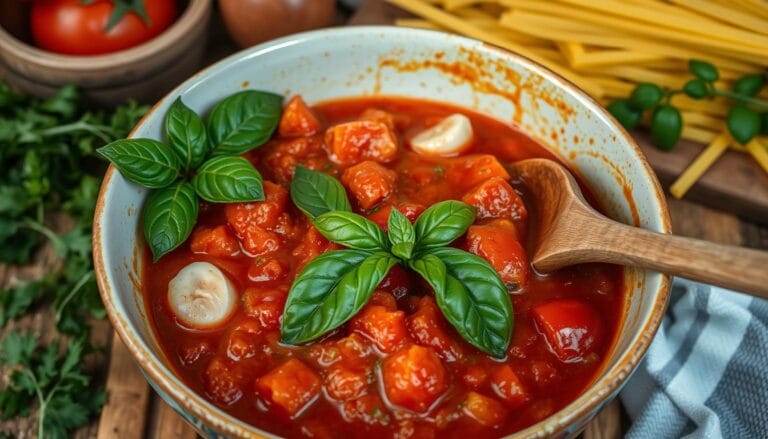Italian cooking is known for its simplicity and rich flavors. A homemade pasta sauce is often the centerpiece of a meal. It combines the joy of cooking with the love of sharing moments together.
Making a quick pasta sauce doesn’t take all day. Its lively taste can brighten up any dinner. Remember the joy of watching grandma make her sauce, filling the kitchen with delicious smells.
This sauce is made with special tomatoes, a key part of Italian cooking. It’s ready in just 10 minutes, bringing Italy’s soul to your table. With the right ingredients, even canned tomatoes can become a homemade pasta sauce that’s as good as any in Italy.
Key Takeaways
- Mastering a simple pasta sauce recipe is both an art and a science, involving quality ingredients and precise timing.
- Authentic Italian pasta sauce supports the benefits of a Mediterranean diet and weight management.
- With a preparation time of 10 minutes, this sauce serves as a quick pasta sauce option for busy lives without compromising on taste.
- Premium canned tomatoes, such as Cirio and Mutti, are a cornerstone of homemade pasta sauce, which is high in both flavor and nutrition.
- Convenience meets quality as this Italian delight is freezer-friendly, extending your culinary endeavors.
- The recipe’s wide appeal is evident. It has been shared numerous times, attesting to its popularity and ease of execution.
Introduction to Homemade Italian Pasta Sauce
Starting to make the best pasta sauce is a journey into Italian cooking. It’s a world of deep flavors and scents, typical of an Italian-inspired recipe. Whether you’re an expert or new to cooking, making a pasta sauce recipe at home is rewarding and tasty.

Making pasta sauce is a way to connect with family or try new things. It’s about using simple ingredients. The magic happens when tomatoes turn into a rich sauce, perfect for pasta. It’s a tradition that brings joy.
The basics of a good pasta sauce recipe are easy: tomatoes, herbs, and olive oil. But what makes each batch special are the details. It’s about mixing flavors, adjusting tastes, and letting it simmer just right. Here’s why homemade sauce is key in Italian cooking:
- Fresh ingredients are the base, with ripe tomatoes at the heart.
- Herbs like basil and parsley add flavor and freshness.
- Homemade Italian tomato sauce can last up to two years when stored right.
Try making your best pasta sauce; you’ll see it’s more than food. It’s a story of flavors, techniques, and traditions. It turns a simple meal into a special one. Whether on spaghetti, in lasagna, or with meatballs, the right sauce adds a touch of Italy.
Quality Ingredients: The Foundation of the Best Pasta Sauce
The secret to a superior pasta sauce is the quality of the ingredients. From the robust flavor of fresh tomatoes to the aromatic allure of fresh herbs, every component is crucial. Brands like Jar Goods and Rao’s focus on using high-quality tomatoes. They show how these ingredients add depth and richness to different types of pasta sauce.
Choosing the Right Tomatoes
Tomatoes are the heart of many Italian dishes, especially pasta sauces. Jar Goods uses vine-ripened San Marzano tomatoes from California. These tomatoes are known for their rich and vibrant flavor, making them a top choice for traditional pasta sauce.
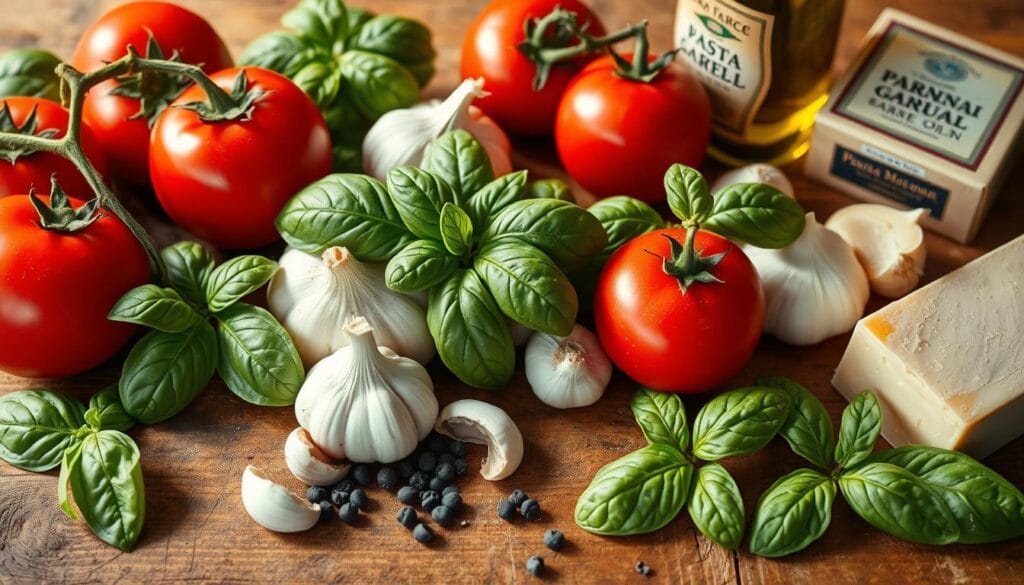
Each 16oz jar of Jar Goods tomato sauce has a balanced mix of garlic, onion, basil, olive oil, salt, and pepper. This blend enhances the flavor, making it a strong contender among pasta sauce types.
The Importance of Fresh Herbs and Spices
Fresh herbs like basil and parsley are unmatched in seasoning. They are key in making an authentic pasta sauce. Rao’s offers a variety of sauces, including ones with herbs and spices, to suit different tastes.
| Brand | Type of Sauce | Highlight Ingredient | Container Size |
|---|---|---|---|
| Jar Goods | Classic Tomato Sauce | San Marzano Tomatoes | 16oz |
| Rao’s | Tomato-Basil | Fresh Basil | Various |
| Rao’s | Bolognese | Meat blend | Various |
| Jar Goods | Vodka Sauce | Cream and Cheese | 16oz |
Knowing the right tomatoes and fresh herbs makes a big difference. It elevates the taste and ensures the richness of pasta sauce from fresh tomatoes is evident. This focus on ingredients is why making the perfect Italian pasta sauce is so important.
Essential Techniques for an Easy Pasta Sauce Recipe
Learning a few key techniques can make your pasta sauce go from good to great. These methods add flavor and make the sauce rich and satisfying. They’re perfect for any pasta dish.
Mastering the Art of Sautéing Garlic
The garlic sauté technique is key for a flavorful sauce. Start by choosing fresh garlic, peel, and mince it finely. Heat some oil over medium heat and add the garlic.
Sauté the garlic for just a few minutes until it’s fragrant and lightly golden. This step is important to avoid burning, making the sauce taste bitter. These tips are crucial for deep flavors and a true Italian taste.
The Secret to a Perfectly Simmered Tomato Sauce
Start with high-quality tomatoes, whether canned or fresh. Add them to your sautéed garlic and bring to a gentle simmer. Then, reduce the heat and let it thicken slowly.
Stir occasionally to prevent sticking and ensure even cooking. This ensures that the sauce coats the pasta evenly, making every bite consistent.
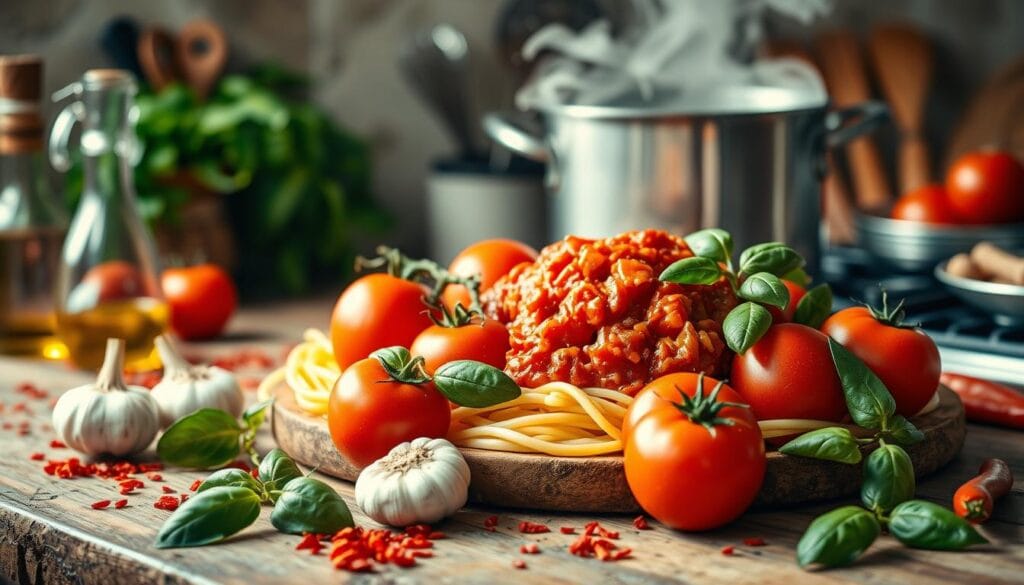
An easy pasta sauce recipe is more than just simple. It’s about the quality of how you make it. Using these techniques keeps your sauce homemade and flavorful. They make a big difference, whether you’re cooking for a quick dinner or guests.
Simple Pasta Sauce Recipe: The 10-Minute Wonder
Life gets busy, and cooking can be a challenge. Our quick pasta sauce turns simple ingredients into a gourmet meal in minutes. It’s perfect for those who want a tasty sauce without spending hours in the kitchen.
Let’s start by making restaurant-quality sauce from canned tomatoes. Tomatoes can be tangy or sweet, making them perfect for personalizing your sauce.
Transforming Canned Tomatoes into Perfection
Begin with tomato paste, sun-dried tomatoes, and high-quality canned cherry tomatoes. Mutti brand cherry tomatoes from Safeway in Northern Virginia are a great choice. They’re sweet and smooth, making your sauce delicious.
- Boil your pasta in salted water.
- Melt butter, then sauté tomato paste for two minutes.
- Add sun-dried tomatoes and a tablespoon of their oil, then stir in cherry tomatoes.
- Crush cherry tomatoes lightly, simmer for 5 minutes, then blend.
- Combine pasta with the sauce, letting it soak up the flavors.
Follow these steps, and your sauce will be ready to serve. For a delicious finish, top it with Parmesan cheese and fresh herbs.
Personalizing Flavor with Basil or Parsley
Basil adds a sweet and peppery taste, while parsley is milder. Customize your sauce with herbs to make it your own. Adding herbs is key to making a simple dish special.
Imagine your pasta with a rich sauce tailored to your taste. This sauce is more than a quick fix. It’s an easy journey into Italian cooking for any home chef.
| Ingredient | Amount | Role in Sauce |
|---|---|---|
| Tomato Paste | 2 tablespoons | Provides a concentrated tomato flavor. |
| Sun-dried Tomatoes | 1/4 cup (packed in oil) | It adds a chewy texture and intense tomato tang. |
| Cherry Tomatoes (Canned) | 1 (14-ounce) can | Gives sweetness and body to the sauce. |
| Unsalted butter | 4 tablespoons | Enriches the sauce, bringing silkiness and depth. |
| Parmesan Cheese | To taste | Enhances seasoning with its salty and nutty profile. |
Looking for the 10 best pasta sauce recipes? Or just a quick dish to impress? This guide will help make your next meal a hit. It’s all about quality and simplicity, making your pasta dishes special.
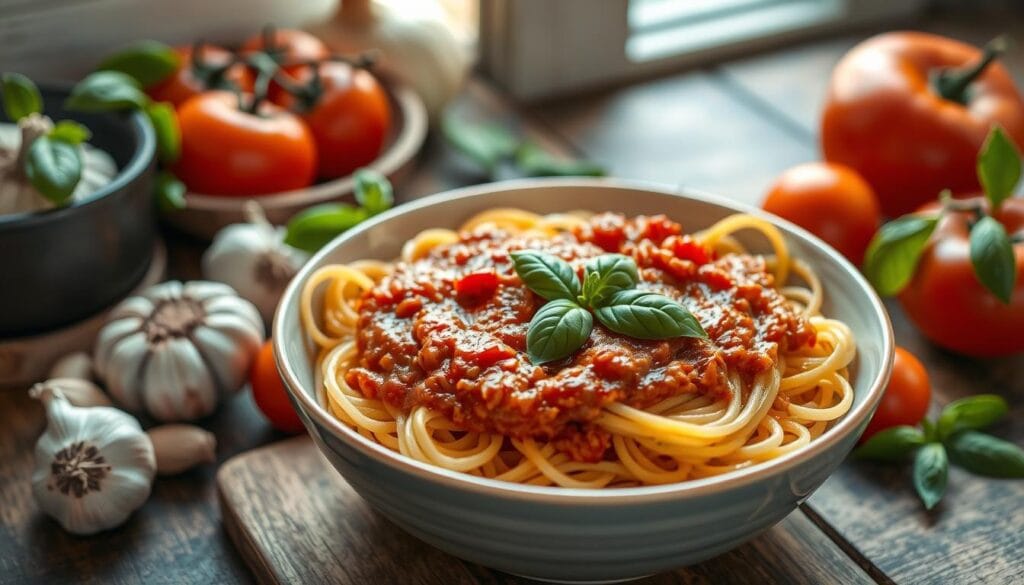
Creating a Richly Flavored Marinara Sauce
The perfect marinara sauce is more than just a spaghetti sauce; it’s a cornerstone of Italian culinary art. You need quality ingredients and a bit of finesse to make a marinara sauce that bursts with flavor. Here’s how to create a hearty and wholesome marinara sauce that tastes great.
Start with the basics: high-quality extra virgin olive oil, onions, and garlic. These ingredients create the aromatic base of a classic marinara. Plus, olive oil is good for your heart, onions help fight inflammation, and garlic boosts your immune system.
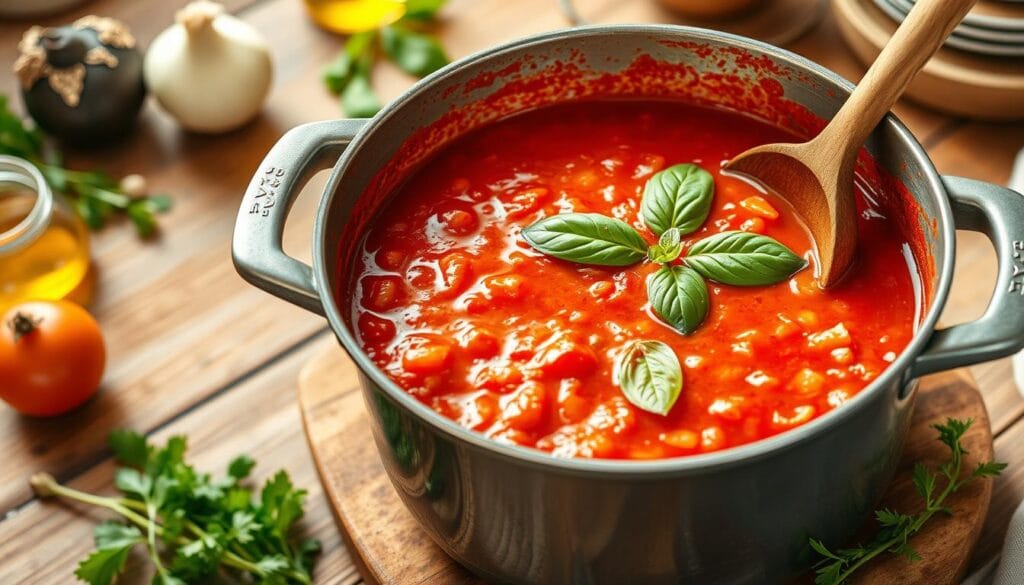
Choose San Marzano tomatoes for their bright flavor and low acidity. Simmer these tomatoes with finely chopped carrots and celery. This adds sweet undertones and extra nutrients like vitamins and fiber.
Preparation & coocking
- Prep time: 15 minutes
- Cook time: 1 hour
- Total time: 1 hour and 15 minutes
Add herbs like dried basil and oregano early to release their flavors. To achieve the perfect spaghetti sauce, taste often and adjust spices and salt slowly. This prevents overpowering the sauce.
To enhance the tomatoes’ natural sweetness, add a bit of maple syrup. This complements the flavors and adds a wholesome richness to your Italian marinara recipe.
After simmering for about an hour, the sauce will be rich and thick. For more gnocchi sauce recipes, check out this resourceful guide.
Adding fresh basil leaves towards the end gives a bright, fragrant lift. Remember, a good marinara sauce takes time. The slow cooking process allows for deep flavors to develop.
Finally, cool and store your marinara sauce in an airtight container. It keeps well in the fridge for up to five days or in the freezer for three months. This makes it a convenient option for quick, nutritious meals.
This marinara sauce is not only delicious but also healthy. It’s low-carb and gluten-free, making it friendly for various diets. Use it over pasta, as a dipping sauce, or as a base for other dishes. It’s a versatile and essential recipe in your kitchen.
The Versatility of Pasta Sauce Types
The world of pasta sauce types is as varied as the regions of Italy from which they originate. Whether you’re whipping up a quick dinner or planning a lavish meal, understanding the different sauce types can elevate your cooking.
Among the pasta sauce types, marinara is known for its simple yet robust flavor profile, making it perfect for spaghetti, while creamy pasta sauce like Alfredo pairs delightfully with fettuccine. Creamy pasta sauces, in particular, can be adapted with various additions such as cheese or herbs to enhance their richness and texture.
Adapting the Base for Creamy Pasta Sauce Variations
Creamy pasta sauces are a testament to the adaptability of Italian culinary traditions. Starting with a basic béchamel or a rich, cheese-based foundation, one can infuse flavors or add ingredients like mushrooms or sun-dried tomatoes to create a hearty dish that complements heavier pasta like pappardelle or shells.
Exploring Regional Italian Pasta Sauce Flavors
Each region of Italy offers unique twists on Italian pasta sauce flavors, such as the spicy kick of arrabbiata from Lazio or the savory depth of a Bolognese sauce typical of Emilia-Romagna. These sauces not only bring a splash of Italian tradition to the table but also pair beautifully with specific pasta shapes to enhance the dining experience. For instance, the thick and meaty Bolognese sauce clings perfectly to broad noodles like tagliatelle.
For those looking to expand their culinary horizons further, exploring the integration of seafood can add a surprising twist to traditional sauces. A flavorful seafood boil sauce can be made using a recipe that emphasizes balancing flavors with fresh ingredients such as butter, garlic, and lemon. Learn how to craft this delightful sauce at this detailed guide.
To fully appreciate the diversity of Italian pasta sauce flavors, consider pairing your dishes with the appropriate wine. For instance, a medium-bodied red wine goes beautifully with a robust marinara, whereas a dry white wine complements the creamy richness of an Alfredo sauce.
Pasta sauce types, particularly creamy pasta sauce variations and regional Italian pasta sauce flavors, offer endless possibilities for customization and experimentation in the kitchen, allowing both novice cooks and seasoned chefs to create dishes that are as nourishing as they are flavorful.
Cooking Pasta to Complement Your Homemade Sauce
Getting the right balance between pasta and spaghetti sauce makes any dish special. It shows the true spirit of Italian cooking. Learning to cook pasta just right and pair it with the best pasta sauce is a valuable skill. We’ll explore how different pasta shapes go with their perfect sauces to spark your creativity in the kitchen.
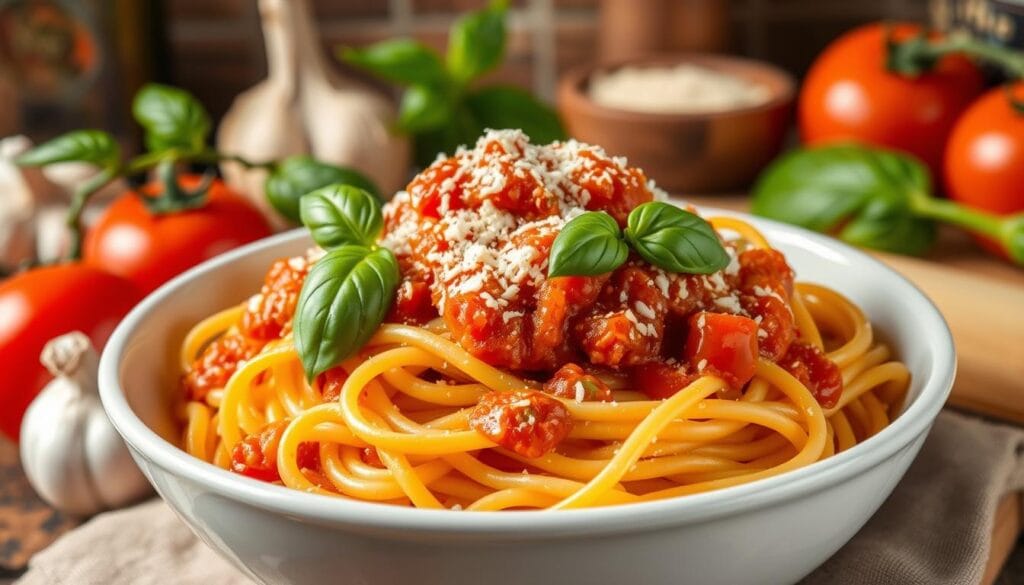
The pasta shape you choose greatly impacts the taste of each bite. For example, penne and rigatoni’s ridges hold onto thick sauces like Bolognese well. On the other hand, light sauces like Carbonara or garlic and oil work best with thin pasta like angel hair.
Pasta selection
| Pasta Shape | Sauce Pairing | Attributes |
|---|---|---|
| Rigatoni, Penne, Ziti | Bolognese, Vegetable Ragu | Suitable for thick sauces due to their ridges enhancing sauce adherence. |
| Ravioli, Tortellini | Sage Brown Butter, Mushroom Cream Sauce | Complements creamy, cheese-filled centers with rich, textured sauces. |
| Fusilli, Rotini | Robust Meaty or Vegetable Sauces | Designed to hold thicker sauces and grated cheeses effectively. |
| Spaghetti, Linguine | Oil-based Sauces, Creamy Sauces like Clams in White Wine | Versatile, perfect for either lighter or creamy sauce options. |
| Fettuccine, Tagliatelle | Alfredo, Heavy Cream or Meat Sauces | Best with heavier, richer sauces that complement the thick noodle. |
Cooking pasta right is key, not just the shape. Boil it in a big pot with lots of water, seasoned like seawater. This method seasons the pasta and prevents sticking without oil. It’s a great way to explore rich Italian dishes.
Another tip from Italian kitchens is to slightly undercook pasta, then finish it in the sauce. This way, the pasta soaks up the flavors, becoming a key part of the dish.
Want to make your kitchen feel like an Italian trattoria? Try different pasta and sauce combinations. Remember to save pasta water to blend the sauce with the pasta perfectly. For tips on making creamy alfredo sauce at home, check out this guide.
Pasta Sauce From Fresh Tomatoes: A Seasonal Delight
Summer brings vibrant flavors, and making homemade pasta sauce from fresh tomatoes is a rewarding project. It uses the best summer produce, turning ripe tomatoes into a delicious sauce. This way, you enjoy the essence of seasonal cooking.
This sauce captures fresh flavors and lets you customize it to your liking. Each tomato variety adds its own taste and texture. This makes the sauce unique and special.
When to Opt for Fresh Over Canned
It’s best to use fresh tomatoes for sauce in mid-summer to early fall. This time ensures the tomatoes are at their peak flavor. Plum, Roma, or cherry tomatoes are great for a fresh tomato pasta sauce because of their bright taste.
Preparing Fresh Tomatoes for Sauce-Making
Preparing tomatoes is key to a great sauce. Start by blanching and peeling them to keep their flavor. Here’s a quick guide on how different tomatoes work in sauce-making:
| Tomato Type | Characteristics | Cooking Note |
|---|---|---|
| Plum (Roma, San Marzano) | Fleshy with fewer seeds | Ideal for thicker, richer sauces |
| Beefsteak | Juicier, larger size | Requires longer cooking to thicken |
| Vine/Campari | Smaller and flavorful | Good for a lighter, fresher sauce |
| Heirloom varieties | Varied textures and flavors | Cook times and results may vary |
For more on making this sauce, check out this detailed recipe from Cookie and Kate. It shows how to make a sauce from fresh tomatoes that’s both rustic and refined.
Using fresh ingredients like in the homemade pasta sauce makes meals special. It’s perfect for quick dinners or meals for guests.
The Role of Herbs in Italian Pasta Sauce
Herbs are key in making a real Italian pasta sauce. They add a lot to its smell and taste. Knowing how to use these herbs is important for anyone wanting to make a simple pasta sauce.
Fresh vs. Dried: Balancing Aromatics
In Italian cooking, choosing between fresh and dried herbs matters a lot. Fresh herbs like basil and parsley are great for adding at the end. This keeps their strong flavors. On the other hand, dried herbs like oregano and thyme are better for long cooking times. This lets their flavors blend well into the sauce.
Incorporating Herbs for Depth of Flavor
Herbs in Italian pasta sauce do more than just add flavor. They add depth and complexity. Herbs like sage, rosemary, and bay leaves give the sauce a rich, earthy taste. This complements the tomato’s tanginess. A good pasta sauce recipe balances these herbs well, showing off Italy’s rich culinary history.
- Basil adds a sweet, peppery taste that brightens the sauce.
- Rosemary has a strong, woody smell that works well in hearty dishes.
- Oregano brings a strong flavor, making it a must-have for classic Italian sauces.
- Parsley, often used as a garnish, adds a fresh, peppery taste to the dish.
It’s the mix and match of these herbs that makes a true Italian pasta sauce stand out.
Health Benefits of Tomato-Based Pasta Sauces
Choosing healthy pasta sauce like tomato-based options is smart. They’re full of vitamins, minerals, and antioxidants. These sauces make your pasta dishes not only tasty but also healthy.
Nutritional Highlights of Tomatoes
Tomatoes, the main ingredient in nutrient-rich tomato sauce, are super nutritious. They’re loaded with vitamin C, vitamin A, and vitamin K. These vitamins help keep your skin, eyes, and bones strong.
Tomatoes also have lycopene, a powerful antioxidant. It helps lower the risk of diseases like cancer and heart problems.
Incorporating Vegetables for a Nutrient Boost
Adding veggies like spinach, mushrooms, and bell peppers to your sauce boosts its nutrition. This mix not only tastes better but also adds more vitamins and minerals. It makes your meal a nutritional powerhouse.
| Nutrient | Benefits | Sources |
|---|---|---|
| Lycopene | Reduces risk of heart disease by 17-26% | Tomatoes, tomato sauce |
| Carotenoids | Decreases risk of lung and prostate cancers by 32-50% | Tomatoes, carrots, sweet potatoes |
| Vitamin C | Antioxidant that protects tissues, enhances immune system | Tomatoes, citrus fruits |
| Fiber | Aids in digestion, controls blood sugar levels | Tomatoes, whole grains, legumes |
| Calcium and Vitamin K | Strengthens bones | Tomatoes, dairy products, green leafy vegetables |
Opting for healthy pasta sauce like homemade nutrient-rich tomato sauce boosts your nutrition. It’s great for your immune health, gut health, and weight management. Adding tomato-based sauces to your diet is a delicious and healthy choice.
Pasta Sauce Recipe No Tomato: Alternative Ingredients
When you don’t have tomatoes, you can still make a great pasta sauce. Use other ingredients to make a alternative pasta sauce that’s creamy and full of flavor. This way, you can try new things and please different tastes. You can choose a creamy sauce or a mix of fresh veggies to make your pasta dish special.
Cream and cheese can make a simple pasta dish feel like a fancy treat. But, if you prefer plant-based options, a sauce made from pureed veggies is a tasty and healthy choice. Let’s look at how to make these tasty sauces:
Using Cream and Cheese for Richness
Mixing cheeses like ricotta or mascarpone with cream makes a smooth, rich sauce. This pasta sauce recipe creamy base is great with light pasta like fettuccine or linguine. It’s a nice contrast to the pasta’s lightness.
Utilizing Vegetables for Unique Sauces
Using veggies, you can make a colorful and healthy pasta sauce. Puree cooked carrots, zucchini, and beets to make a vibrant sauce. This sauce adds color and nutrients to your meal, making it both healthy and tasty.
Vegetable-based sauces are a hit for their bold flavors and health benefits. A mix of celery, carrots, zucchinis, and beet with broth makes about 3 1/2 cups of sauce. It’s seasoned with herbs and spices, perfect for 4 servings. Check out this collection of tortellini sauces for more ideas to go with your pasta.
The sauce keeps well in the fridge for up to 5 days or can be frozen for up to 3 months. This makes it easy to enjoy a gourmet sauce even on busy days. It saves time and brings big flavors to your meals.
Trying out dairy or veggie-based sauces adds variety to your pasta nights. It makes every pasta dish exciting and different.
Advanced Tips for a Full-Flavored Pasta Sauce
Want to make your pasta dish stand out? Focus on the sauce. Adding umami-rich ingredients is key. Parmigiano-Reggiano cheese and anchovies can add deep, savory flavors. In our taste tests, these ingredients made a big difference.
Utilizing Umami-Rich Additions
Adding umami to your sauce should enhance, not overpower, other tastes. Try mixing red pepper flakes, olives, and lemon zest for depth. Also, heating jarred sauces for 10 to 20 minutes or baking them can boost flavor.
Think about adding sautéed mushrooms, bacon, or Italian sausage. They bring strong flavors and textures to your sauce.
Balancing Acidity and Sweetness
Creating a balanced pasta sauce is all about acidity and sweetness. Jarred sauces can be improved by heating them up. This caramelizes sugars and enhances aromas.
Just like homemade sauce, treat store-bought sauce with care. A bit of vinegar or sugar can change everything. Adding fresh basil or olive oil at the end can also make a big difference.
FAQ
How do you make a simple Italian pasta sauce at home?
Start with top-notch canned tomatoes. Add fresh herbs like basil or parsley. Sauté garlic carefully, then simmer for 10 minutes for a rich sauce.
What are the secrets to the best homemade pasta sauce?
Choose premium tomatoes like Cirio and Mutti. Add fresh herbs for flavor. Let the sauce simmer to concentrate the taste.
Can you make a flavorful pasta sauce using canned tomatoes?
Yes! Good canned tomatoes can make a tasty sauce with garlic and simmering. This method enhances the tomato flavor.
What herbs and spices are essential for an authentic Italian pasta sauce?
Use fresh basil, oregano, parsley, and thyme. They add a bright taste. Dried herbs give a deeper flavor.
How do you sauté garlic properly for pasta sauce?
Heat oil and garlic together over medium heat. This way, the garlic flavors the oil without burning, avoiding bitterness.
Why is simmering important for making tomato sauce?
Simmering thickens the sauce and intensifies flavors. It also caramelizes tomato sugars, enriching the sauce.
What makes marinara sauce unique, and how do you craft a good one?
Marinara is a simple sauce with tomatoes, garlic, herbs, and olive oil. Use high-quality tomatoes for a sweet and tangy sauce.
What are some variations I can make with a basic pasta sauce recipe?
Add cream or cheese for a creamy sauce. Try different spices and vegetables for unique Italian flavors.
How do I cook pasta to match my homemade sauce?
Cook pasta until al dente. Save pasta water to add to the sauce. This helps it cling to the pasta.
When should I choose fresh tomatoes over canned for pasta sauce?
Use fresh tomatoes in peak season for a lighter sauce. They’re more flavorful than canned.
How do you prepare fresh tomatoes for sauce-making?
Blanch tomatoes in hot water, then ice bath. Peel, remove seeds, and chop before using in your sauce.
What are the health benefits of tomato-based pasta sauces?
Tomato sauces are full of vitamins C and K, potassium, and iron. Adding veggies boosts their nutritional value.
Can I prepare a pasta sauce without tomatoes?
Yes, use cream, cheese, and veggies for unique sauces without tomatoes.
How do I enhance the flavor of my pasta sauce?
Add Parmesan cheese or anchovies for depth. Adjust acidity and sweetness for a balanced flavor.

